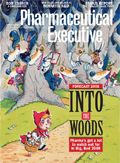Lincoln, Digger, and the Rest of the Gang
We asked seven industry experts to talk about today's best (and worst) pharma icons
Jamie Cobb, executive creative director, Micromass: When used to represent a brand, an icon should evoke strong associations and specific attributes, both emotionally and rationally. For these reasons, I think Lunesta has hit the mark with its use of the moth. The characteristics and behavior of the icon match well with the product attributes—calm, gentle, comforting sleep. Paired with the brand's execution of the creative and the seamless consumer and professional media strategy, it's no wonder this campaign is one of the most recognized.

Steven Goldstein, managing partner, LHG: The one that really came to mind for me as the most memorable and powerful was the Lovenox shark. It's not totally current, but to me it's far better than anything out there. It's an image of platelets and fibers linking together in the shape of a shark. It shows instantly and urgently the danger of a clot that can kill. It doesn't even need words, but the original words that went with it were beautiful: "When a killer clot threatens, Lovenox wastes no time." It's just one of the most powerful images that I've ever seen. And I know they've stuck with it; they've used the shark again in other ads in the series over time. It's just an icon that I wish I had done. I don't know that there are any other icons in the recent past that have had the longevity of the Lovenox shark. There's a lot of good stuff out there, but this one stands out.

Michael Sanzen, partner, director of creative services, Concentric: The Viagra blue-diamond pill is a great example of a company thinking about building a brand from the earliest stages of product development. I think one of the reasons you see so many cartoon characters, apples, bulldogs, and things like that in this business is because we don't have something tangible to show and to sell that evokes an emotion. That's why I love the blue-diamond Viagra pill. It gives us something tangible that actually does speak to some of the benefits of the product. It's premium; it's romantic. And it's something that I will give the agency and the marketing team credit for recognizing and showcasing in every piece. If you think about their messaging and look at their materials today, like the consumer Web site—not to be crass—but the word hard is everywhere. It's a tasteful way to talk about quality, romance, and now, ultimately, firmness.

Jeffrey Scott, president, Mohrman/Scott Associates: Product management has to stick with an icon. For example, the Prevacid tummy had been a key part of the advertising campaign for 10 years. Then, apparently, TAP Pharmaceutical changed agencies and all but abandoned the campaign. It's still in the advertising, but they reduced it to a postage stamp. In fact, we did a study about a year ago with a journal in which there had been a Prevacid ad that had a very burly-looking, tattooed man holding the tummy in his arms, as if he were comforting it. The ad scored 50 percent above the issue norm and twice what you would expect it to do for its size and type. Half the docs who saw it came away with an advocacy message. Later, we tested another Prevacid ad, after TAP had switched agencies, and the ad bombed. The tummy was working for them for years, and they walked away from it. I worked for an agency that had a Procter & Gamble account, and Procter had a dictum that applied to all product managers: The brand is sacred. The first thing product managers want to do when they join a brand is make their mark, do some changes in the advertising, because that's a very visible thing and is very tempting. P&G's standpoint on it was that you can't do that. They built that product and its advertising over years, and for someone to come in the course of his term and attempt to abandon that effort doesn't make sense.

Lisa Flaiz, VP, group director and national pharma practice lead, Avenue A|Razorfish: We've moved away from the talking white coat as a creative strategy. The Chantix tortoise-and-hare campaign is definitely one of my new favorites. It's so great because it delivers on insight that Pfizer has obviously learned from research. People who have tried to quit smoking before have learned that it doesn't usually happen the first time. It might be a stop-and-start process. It's a slow, steady thing. I like how the tortoise and the hare represent the slow-and-steady approach versus the cold-turkey approach. I think the creative treatment is fabulous and memorable. It's a story that everybody gets; it goes right to your childhood but not in a childish way. We're starting to see the Mirapex paintbrush swatches. It's not really a character, but it used art and a graphic to represent the patient and the disease state and to break through a little bit. Mirapex had to do something totally different from Rozerem because Rozerem went off the deep end. And I love the Celebrex word art. Again, the word art is not a cartoon character, there is no icon there. Also, using text graphics is not new, but Celebrex did it in a way that showed a slice of life. So I think this creative trend we're seeing away from the white coats is positive. We're finding new ways in pharma to do things creatively and to continue to deliver fair balance in a way that isn't a voiceover over shiny happy people.

Raz Crowe, vice president, creative services, Roska Healthcare: In general, pharma advertising is catching up with consumer, but it's still five, six years behind the curve. You're taking your brand and tying it to something less obnoxious than a bleeding sore or painful rectal itch. It's smart marketing. I love the Lamisil critter, Digger. That was really good. But I can never figure out why the Nasonex bee has this pseudo French/Spanish accent. I'm not in love with the female symbol coming off of the bathroom door and talking about Detrol, either. That one bothers me. And I hate the happy people on the beach in the Valtrex ads. If you had something like a critter that protects people from herpes, that would be better and more heroic.

I love the Rozerem ads. I'm not saying they work for everybody. But as an ad guy, I love them. Is Abe Lincoln my conscience, or is he just plain Abe Lincoln? Is the beaver the beaver, or does he represent my dreams and aspirations? What's the deep-sea diver doing in the back? They're cutting edge. It may not be the most generally accepted ad, but you have to respect whoever pulled that off. I would love to have been in the pitch meeting when they signed on the line. That was extremely brave. I'd love to see more people doing stuff like this, I really would. In Europe, they're more apt to do things like this. It might be that US culture is more conservative. When I travel to Europe, I see more cartoons in pharma ads.
Mark Stevens, author, God Is a Salesman: I find the Rozerem beaver to be intriguing because of its relationship to the dream. That's a great way to talk about dreaming and to visualize it. The whole category of sleep aids has grown so dramatically, driven not only by need but by the desire to have something better. I think the beaver gives you the sense that there's a richness to the night that you may be missing. Of course, any advertising at all is only as good as the sales it generates, and I stick to that philosophy. But if you talk to me about personally identifying a favorite, I absolutely love the Rozerem ads. I love the Lunesta moth too. I actually bought the product because of that commercial. I was disappointed with the product, but they'd sold me on it. I liked the idea of waking up and stretching my arms out in the morning, having a great night's sleep, waking up with a desire to take the world on.


The Misinformation Maze: Navigating Public Health in the Digital Age
March 11th 2025Jennifer Butler, chief commercial officer of Pleio, discusses misinformation's threat to public health, where patients are turning for trustworthy health information, the industry's pivot to peer-to-patient strategies to educate patients, and more.
Navigating Distrust: Pharma in the Age of Social Media
February 18th 2025Ian Baer, Founder and CEO of Sooth, discusses how the growing distrust in social media will impact industry marketing strategies and the relationships between pharmaceutical companies and the patients they aim to serve. He also explains dark social, how to combat misinformation, closing the trust gap, and more.